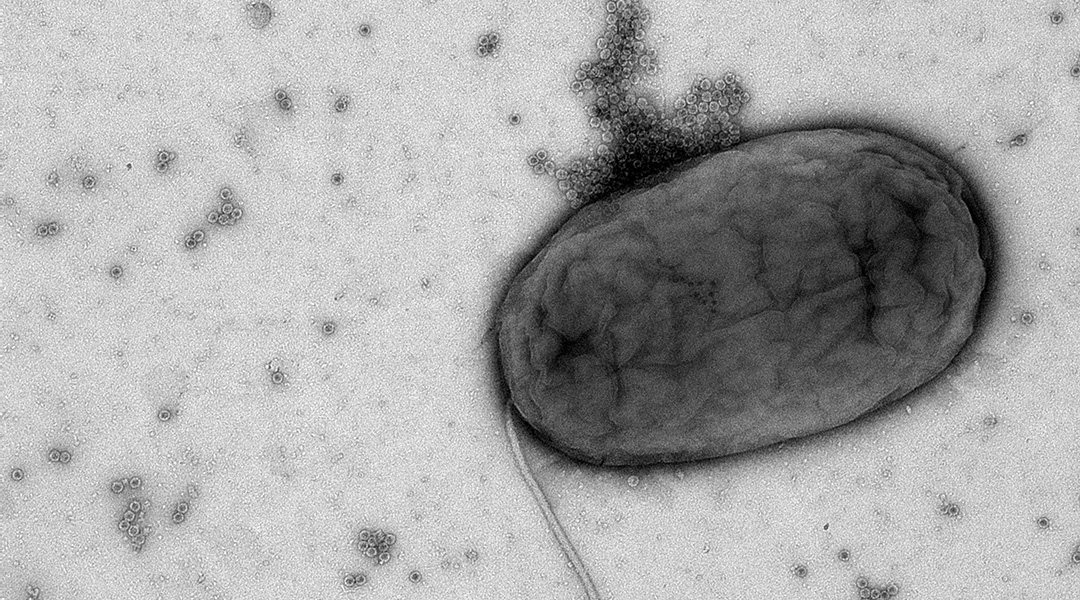Joining forces with bacteria’s natural enemy — bacteria-infecting viruses known as bacteriophages — a group of scientists has developed an antibacterial material for use in medicine and the food industry.
“Bacteriophages have a well-defined nanoscale size, shape, and surface chemistry, making them promising candidates for creating advanced biomaterials,” wrote the scientists in their study published in Advanced Functional Materials.
The scientists created the antibacterial material through the self-assembly of the bacteriophage, Qbeta, a naturally occurring icosahedral-shaped virus with a diameter of only 29 nanometers, with a synthetic polycation known as poly [2-(methacryloyloxy)ethyl] trimethylammonium chloride, or pMETAC for short. pMETAC has been previously used for developing antimicrobial surfaces.
Virus and polycation, a winning combination
The assembly of virus and polycation generated a colloidal crystal, which is a material composed of nano- or micron-sized particles arranged in a highly ordered and symmetric structure within a solution. The crystals are then easily separated from the liquid solution to form a gel, which serves as the basis for this bacteria-killing material.
“To form such crystals from particles in solution, one needs to overcome the repulsive interaction between the particles and align them symmetrically,” said Stefan Salentinig, a chemist and professor at the University of Fribourg in Switzerland and lead author of the study. This normally means that materials of this nature are difficult to produce.
To eliminate this repulsive chemical force, the team mixed the icosahedral viral shells with the pMETAC polycation, which contains multiple positively charged sites, acting as a sort of glue that helps the viral particles arrange themselves.
“[Treating Qbeta bacteriophages with pMETAC molecules in solution] led to the symmetric aggregation of the Qbeta cages, forming large and highly geometrically structured aggregates,” said Salentinig.
“Usually, such 3D-nanostructured materials require complex synthesis steps,” he continued. “Here, it was possible to create [them] by simply mixing a polycation with the viruses.”
Nano-templating to create antibacterial coatings
After the phage’s self-assembly in the presence of pMETAC, the team tested whether the virus was still able to infect and kill bacteria. Salentinig and his team compared this ability to Qbeta bacteriophage without pMETAC with a test commonly used in the lab called a plaque assay.
In this test, the virus is added to plates with growing bacteria, and over time, as the viruses infect and kill bacteria, they create visible areas of dead cells called plaques. By counting the number of plaques formed by the assembled and untreated phages, the scientists found that they both killed bacteria in a similar way.
“The findings are significant as they open new pathways to create hierarchically structured materials for various applications, including nano-templating,” said Salentinig.
Nano-templing is a technique that scientists use to create tiny, nanoscale structures by using a template or mold, normally applied in advanced technology or medicine. In the scenario of Qbeta-based bactericides, with nano-templing one could create antimicrobial coatings for surfaces, such as medical devices, that prevent bacterial growth.
Beyond just an antibacterial surface
Salentinig says that this new technology could also have other potential applications in medicine. For example, it could be used to treat gut infections.
“They [the assembled bacteriophages] could kill harmful bacteria without affecting beneficial ones,” said Salentinig. “Virus colloidal crystals could also be of interest for drug delivery or to make more effective vaccines, delivering multiple active particles to specific locations by targeting cells.”
The material’s application extends beyond medicine to the food industry. “Colloidal crystals from virus solution can be used to develop coatings or supraparticles that target and eliminate pathogenic bacteria while preserving probiotic strains, [for example,] in the cheese and diary industries,” said Salentinig.
The team believes that this technology could be scalable and say it has great versatility, as different viral capsids could be used and the viral material inside could be exchanged with biomaterials to deliver nutrients, drugs, or biomolecules.
“We are only starting to understand how we can tune structural symmetries and create even more advanced materials using this simple approach,” said Salentinig.
Reference: Bettina Tran, et. al., pH-Responsive Virus-Based Colloidal Crystals for Advanced Material Platforms, Advanced Functional Materials (2024). DOI: 10.1002/adfm.202402257

















